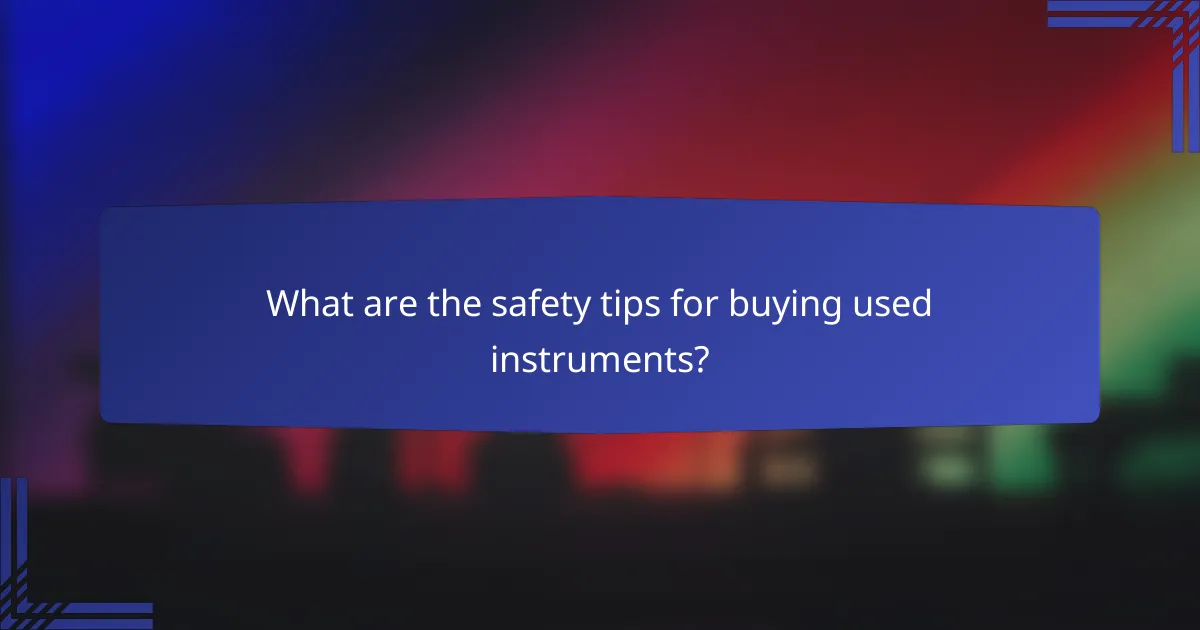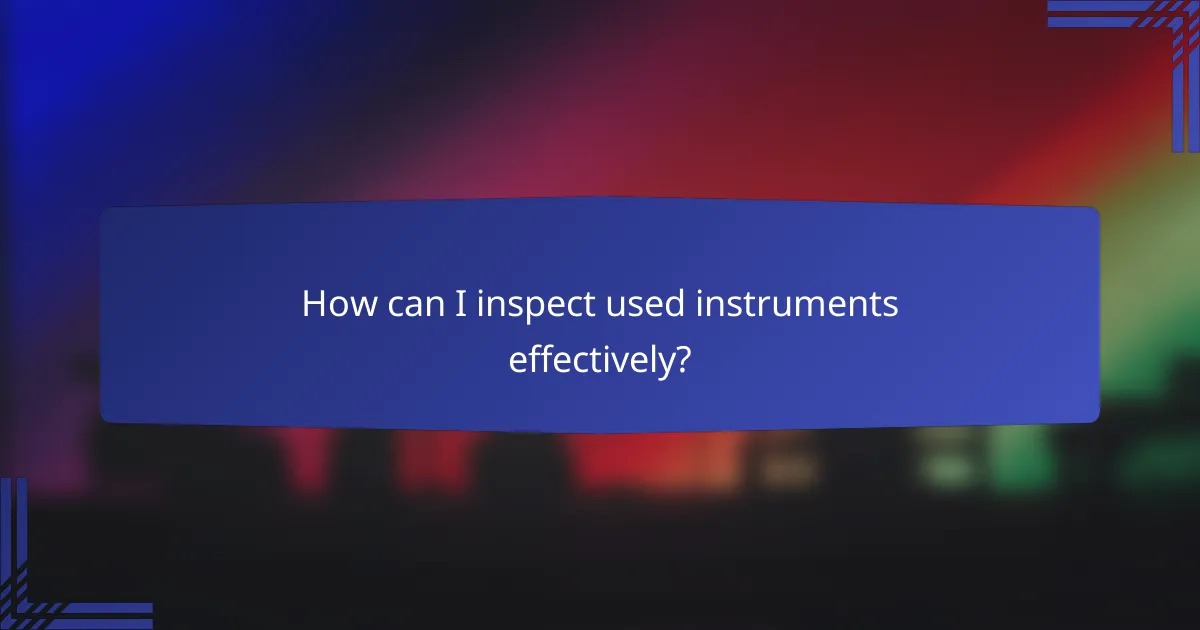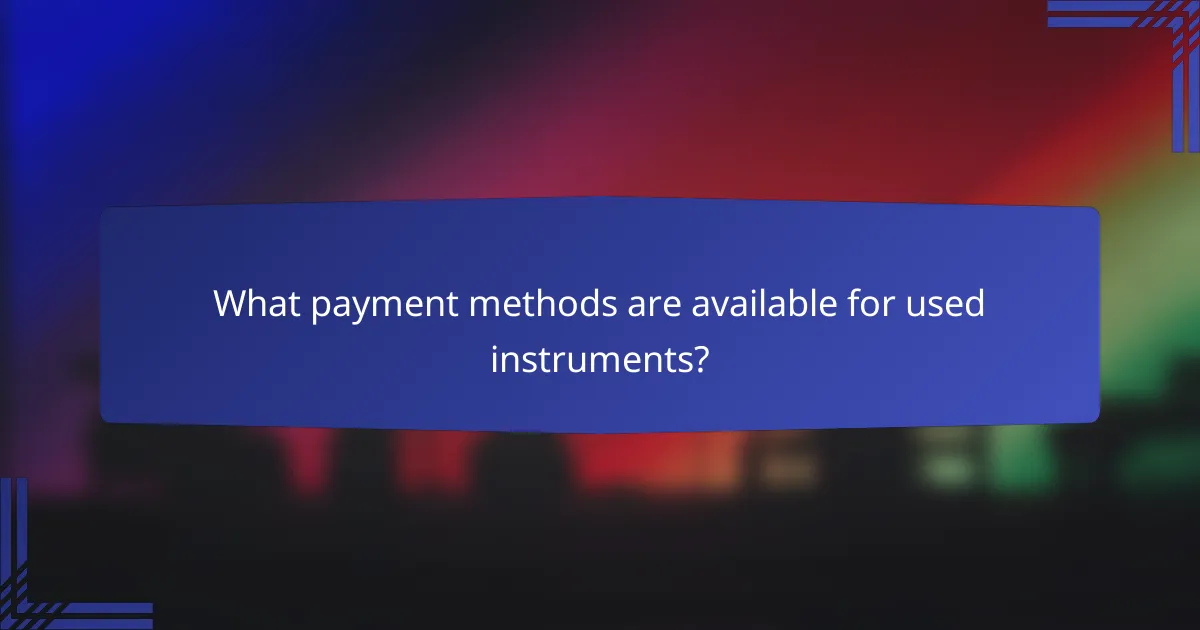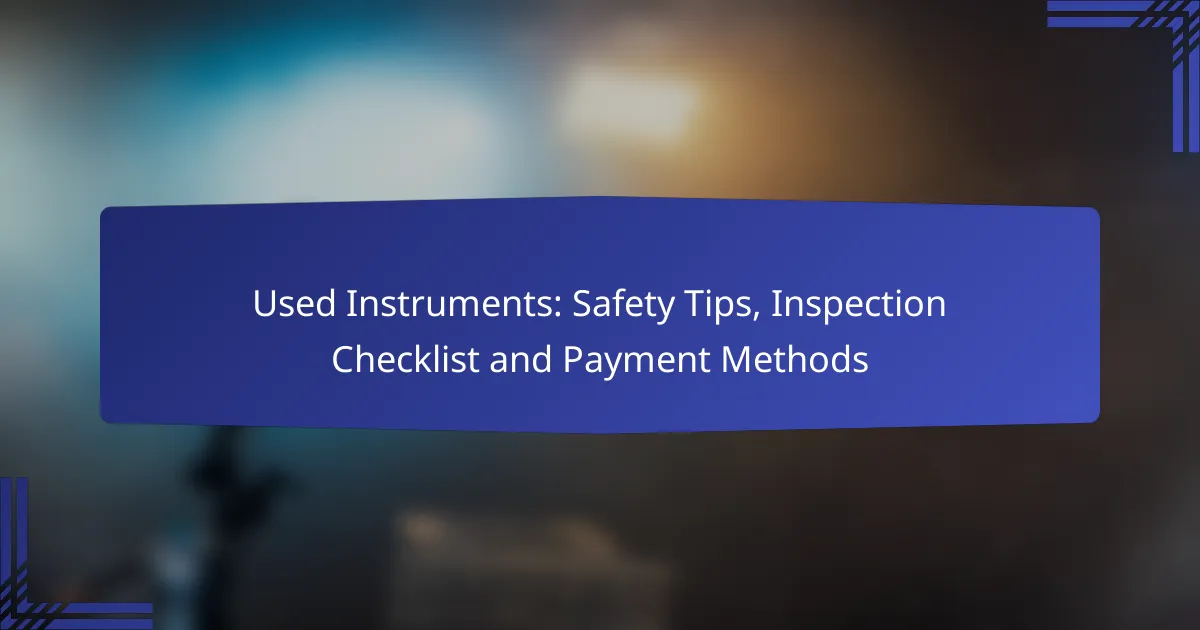Buying used instruments can be a rewarding experience, but it’s essential to prioritize safety and make informed decisions. Thoroughly inspecting the instrument’s condition and sound quality, along with verifying the seller’s reputation, can help you avoid potential pitfalls. Additionally, understanding the various payment methods available will ensure a smooth transaction and protect your investment.

What are the safety tips for buying used instruments?
When buying used instruments, prioritize safety by thoroughly inspecting the item, verifying the seller’s reputation, and understanding the return policies. These steps help ensure you make a sound investment and avoid potential issues.
Inspect for physical damage
Begin by examining the instrument for any visible signs of damage, such as dents, scratches, or cracks. Pay close attention to the body, neck, and any moving parts, as these can affect performance and longevity.
Use a checklist to guide your inspection: look for loose hardware, worn pads, or rust on metal components. If possible, take the instrument to a professional for a more thorough evaluation.
Check for proper functionality
Test the instrument to ensure it operates correctly. For string instruments, check the tuning and playability; for wind instruments, ensure there are no leaks and that all keys function smoothly.
Consider bringing along a knowledgeable friend or teacher to help assess the sound quality and playability. If the instrument has electronic components, test them to confirm they work as intended.
Verify seller reputation
Research the seller’s background to ensure they are trustworthy. Look for reviews or testimonials from previous buyers, and check their history on platforms like eBay or Reverb.
Engage with the seller directly to gauge their knowledge and willingness to answer questions. A reputable seller should provide clear information about the instrument’s condition and history.
Ask about previous ownership
Inquire about the instrument’s previous owners and how it was used. Instruments that have been well-maintained by professional musicians often have better longevity compared to those owned by beginners.
Ask for any maintenance records or service history, as this can provide insight into the instrument’s care and potential future issues.
Review return policies
Before finalizing your purchase, understand the seller’s return policy. A flexible return policy allows you to return the instrument if it does not meet your expectations or has undisclosed issues.
Look for sellers who offer a satisfaction guarantee or a trial period, as these options provide additional peace of mind when buying used instruments.

How can I inspect used instruments effectively?
To inspect used instruments effectively, focus on a thorough evaluation of their condition, sound quality, and any signs of wear. This process ensures you make an informed decision and avoid potential issues after purchase.
Use a detailed inspection checklist
A detailed inspection checklist helps you systematically evaluate the instrument’s condition. Include items such as the body, strings, keys, and electronics, depending on the type of instrument.
For example, if inspecting a guitar, check the neck for warping, the frets for wear, and the electronics for functionality. You can create a checklist that includes:
- Body condition
- String and fret wear
- Electronics functionality
- Overall playability
Test sound quality during purchase
Testing sound quality is crucial when buying used instruments. Play various notes and chords to assess the instrument’s tonal clarity and resonance.
For string instruments, listen for any buzzing or dead spots, while for wind instruments, ensure that all keys function smoothly and produce clear sounds. If possible, compare it to similar models to gauge sound quality differences.
Look for signs of wear and tear
Signs of wear and tear can indicate how well the instrument has been maintained. Look for scratches, dents, or rust, which may affect performance and longevity.
Pay attention to the condition of consumable parts, such as strings and pads, as these may need replacement soon after purchase. A well-maintained instrument will show minimal wear, while excessive damage may require costly repairs.

What payment methods are available for used instruments?
When purchasing used instruments, several payment methods are commonly accepted, including credit cards, PayPal, and escrow services for high-value transactions. Each method has its own advantages and considerations that can affect your purchasing experience.
Credit card payments
Credit card payments are a popular choice for buying used instruments due to their convenience and buyer protection features. Most sellers accept major credit cards, allowing for quick transactions and the ability to dispute charges if necessary.
However, be aware of potential fees that sellers may impose for credit card transactions, which can range from 2% to 4%. Always confirm the total cost before finalizing your purchase to avoid surprises.
PayPal transactions
PayPal is another widely used payment method for purchasing used instruments, offering both buyer and seller protections. With PayPal, you can easily send money using your bank account or credit card, making it a flexible option.
Keep in mind that PayPal may charge fees for certain transactions, particularly if currency conversion is involved. Always check the fee structure and ensure you are aware of any potential costs before proceeding with your payment.
Escrow services for high-value items
For high-value used instruments, escrow services provide an added layer of security for both buyers and sellers. An escrow service holds the payment until the buyer confirms receipt and satisfaction with the item, reducing the risk of fraud.
While using an escrow service can incur additional fees, typically ranging from 1% to 3% of the transaction amount, it can be a worthwhile investment for expensive purchases. Ensure you choose a reputable escrow service to safeguard your transaction effectively.

What are the common risks when purchasing used instruments?
When purchasing used instruments, common risks include hidden defects, counterfeit products, and the potential loss of warranty. Being aware of these risks can help buyers make informed decisions and avoid costly mistakes.
Potential for hidden defects
Used instruments may have hidden defects that are not immediately visible. These could include internal damage, wear and tear, or issues with functionality that only become apparent after some use. Always consider having a qualified technician inspect the instrument before finalizing a purchase.
To mitigate this risk, ask for a detailed history of the instrument, including previous repairs and maintenance records. If possible, test the instrument thoroughly before buying it to ensure it meets your expectations.
Risk of counterfeit products
The market for used instruments can include counterfeit products, which may look authentic but lack quality and reliability. Counterfeit instruments can lead to poor performance and safety hazards. Always purchase from reputable sellers and verify the authenticity of the instrument.
Check for serial numbers, brand markings, and any certifications that prove the instrument’s legitimacy. If a deal seems too good to be true, it probably is, so exercise caution and conduct thorough research.
Loss of warranty
Buying used instruments often means losing the manufacturer’s warranty, which can leave you unprotected against defects or failures. Some warranties are not transferable, so it’s crucial to confirm the warranty status before making a purchase.
Consider the potential costs of repairs or replacements when evaluating a used instrument. If the instrument is expensive or critical to your work, weigh the benefits of a new purchase against the savings from buying used.

How do I choose a trustworthy seller for used instruments?
To choose a trustworthy seller for used instruments, prioritize those with a solid reputation, transparent practices, and positive customer feedback. Look for sellers who provide detailed information about the instruments and have a clear return policy.
Check online reviews and ratings
Online reviews and ratings are crucial for assessing a seller’s reliability. Start by searching for reviews on platforms like Google, Yelp, or specialized music forums where musicians share their experiences. A seller with consistently high ratings and positive feedback is generally more trustworthy.
Pay attention to the volume of reviews as well; a seller with a few glowing reviews may not be as reliable as one with a larger number of mixed reviews. Look for comments that specifically mention the condition of the instruments, customer service, and the overall buying experience.
Additionally, consider checking social media platforms for customer interactions. Sellers who engage positively with their customers and address complaints promptly are often more dependable.
